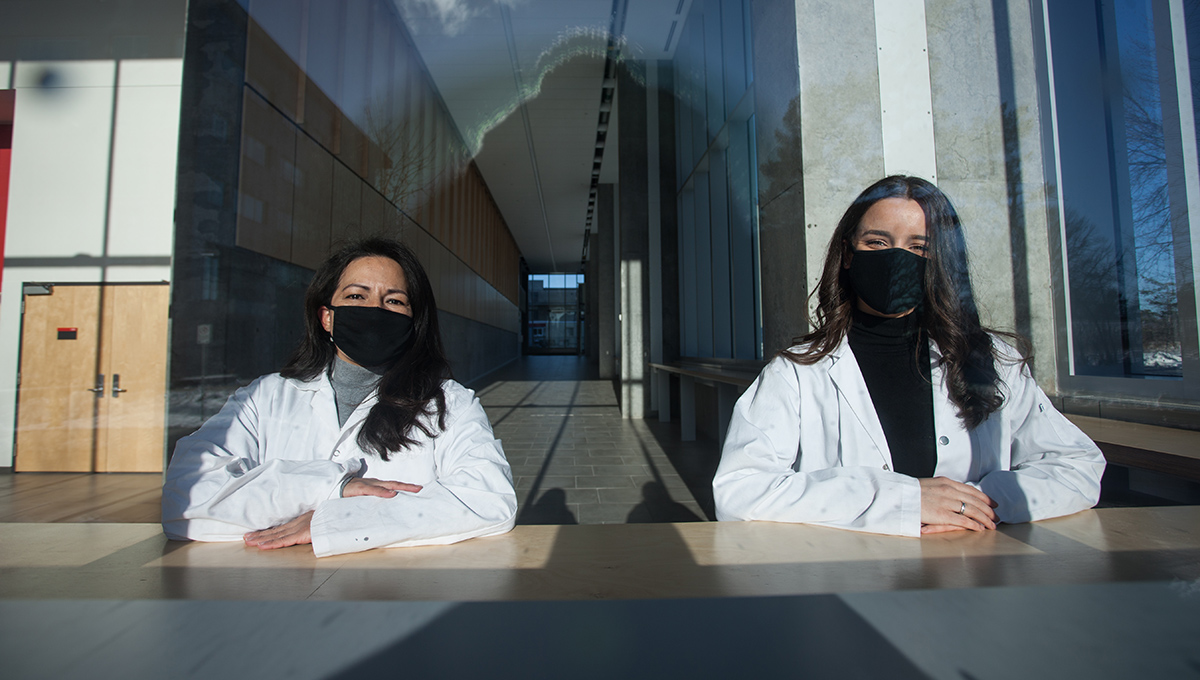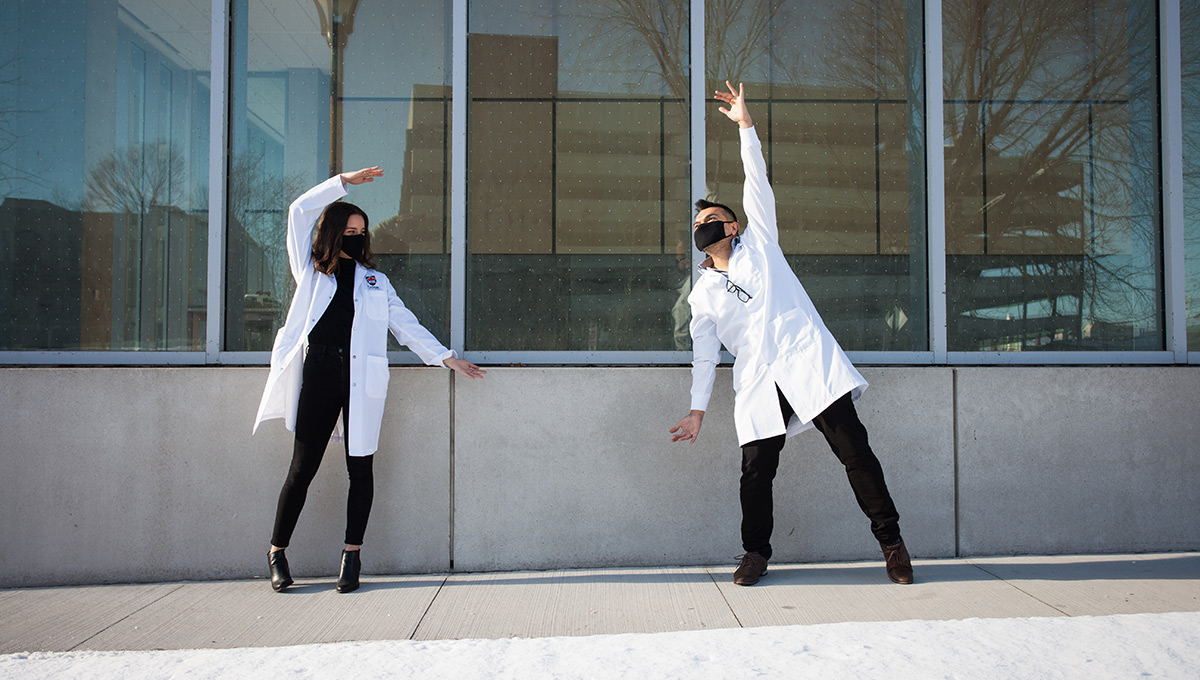By Dan Rubinstein
Photos by Fangliang Xu
Among its many impacts, the COVID-19 pandemic has increased awareness about mental health concerns and limited access to labs for scientists.
But Carleton University Neuroscience Prof. Argel Aguilar-Valles and his collaborators continue to chip away at experiments in the Health Sciences Building — and they have discovered a key piece of the puzzle that explains why an emerging treatment for major depression shows promising results.

Prof. Argel Aguilar-Valles
Roughly one-third of patients diagnosed with debilitating mood disorders don’t respond to conventional pharmaceuticals such as selective serotonin reuptake inhibitors (SSRIs), more commonly known by brand names like Prozac and Zoloft. But when the same patients are given the drug ketamine — which earlier this year was approved for use in supervised clinical settings in Canada — their depressive symptoms, along with thoughts of suicide and other self-harming behaviour, cease almost immediately.
In a paper recently published in the prestigious multidisciplinary journal Nature, Aguilar-Valles details how his experiments with mice have revealed the molecular mechanism behind the rapid and long-lasting effects of ketamine.
“We’re a step closer to determining what makes it work as an anti-depressant,” he says.
“It’s really important to understand these processes — to study them systematically to learn how these treatments do what they do. And if there are negative consequences, maybe we can find alternatives and design a drug that’s safer than ketamine for people to use.”

The Chemical Roots of Psychological Problems
Aguilar-Valles, who is from Mexico originally and came to Carleton nearly two years ago after finishing a postdoctoral fellowship at McGill University in Montreal, developed an interest in using animal models to demystify mood disorders during his PhD studies at McGill.
“They were always something that intrigued me,” he says.
“As a neuroscientist, I often heard a psychological point of view, but I knew that there’s also a chemical and cellular substrate.”
After completing his doctorate, Aguilar-Valles did a postdoc at the Scripps Research Institute in Florida, investigating the mechanisms underlying the formation of aberrant memories linked to substance abuse, then returned to McGill for a postdoc with renowned biochemist Nahum Sonenberg, a protein synthesis expert who does research on the cellular minutia behind conditions ranging from cancer to mood disorders.

That experience — and a theory that the neuroplasticity seen during memory formation could also be triggered by anti-depressants — led Aguilar-Valles to his work with ketamine.
Ketamine was developed in the 1960s for use as an anesthetic but was soon co-opted as a street drug, known by names such as Special K and desired for its hallucinogenic side effects.
Because of its potential for abuse and addiction, ketamine is considered a “dirty drug,” says Aguilar-Valles. Yet when it’s given to patients who have gone through unsuccessful rounds of SSRIs, even one dose can have a profoundly positive impact.
“There’s a large population of patients who don’t respond to conventional treatment,” he says.
“Psychotherapy is a good option, but it takes time, and sometimes you need solutions that will help a patient more quickly.”

Finely-Tuned Pharmaceutical Treatments
When people form new memories, cells in the brain physically change. Neural synapses and pathways are altered. Ketamine has a similar impact.
Aguilar-Valles and others are doing research to better understand precisely what happens when people are given ketamine, and why, so that they can ultimately help develop finely-tuned pharmaceutical treatments.
To do this, they conduct experiments with mice and look at what happens to the animals’ brains, both by analyzing tissue samples at a cellular level and by studying mice behaviour.
For the latter, some mice are given ketamine, a control group of mice is not, and all are subjected to stress inducing situations.

For example, mice, which are natural swimmers, are put in large beakers of water with no way to get out. The mice that have been given ketamine will actively swim around and look for an escape, while the control group mice will be much more passive until they are safely removed from the water.
Another experiment involves not feeding mice overnight as usual, then in the morning putting them in a brightly lit cage with food pellets in the middle. The mice that have been given ketamine will quickly approach and eat the food — overcoming their tendency to be afraid of open spaces — while the control-group mice remain at the edge of the cages longer.
The data that researchers generate in these experiments rely on an interpretation of animal behaviour, Aguilar-Valles cautions. But coupled with the laboratory analysis that his group was able to resume in a restricted capacity after the early weeks of last spring’s pandemic lockdown — wearing masks, washing hands and disinfecting surfaces frequently were already typical lab practices — the overall findings are promising.
“It’s been challenging — we had to stop our experiments for a while, and now there can only be one person in a room at a time,” says Aguilar-Valles.
“We’ll have to work hard to catch up when we’re back to full speed. But everybody in the world is going through this, and it really makes you appreciate the value of in-person research and teaching.”

Student Contributions a Key to Lab Work
Until this past summer, Aguilar-Valles’s collaborators included his wife Edna Matta-Camacho, who was a fellow postdoc at McGill.
Matta-Camacho came to Carleton at the same time as Aguilar-Valles and helped him start his new lab, supervising students and teaching lab techniques. She’s now moved on to a job at Health Canada evaluating new drugs on the market.

Edna Matta-Camacho
Fourth-year Neuroscience and Mental Health student, Emily Arsenault, is also part of the research group.
Arsenault — whose honours thesis is a followup to the ketamine project that was published in Nature — is in the lab in Carleton’s Health Sciences Building a couple times a week these days, analyzing mice brains to determine whether structural changes match up with the observed behavioural changes.
She is examining the expression of different proteins in mice brains — proteins that are markers of neuroplasticity, which essentially indicate the brain’s ability to grow and change. More specifically, she is examining the receptors on neurons that ketamine acts on.
Data is still preliminary, she says, but it looks like changes in mice brains associated with chronic stress could be reversed by ketamine.

Emily Arsenault
Arsenault enjoys spending time in the lab right now — “it’s a nice break from Zoom university,” she says — and likens it to being on campus when it’s quiet over the weekend in normal times. And though she misses the camaraderie of professors and other students, she’s happy to be part of a timely research project.
“Depression is one of the most common illnesses and most common causes of disability,” she says.
“Front-line treatments don’t work for a lot of people and ketamine has a lot of possibilities. We’re contributing to an important body of knowledge.”

Monday, January 11, 2021 in Mental Health, Neuroscience, Research
Share: Twitter, Facebook



